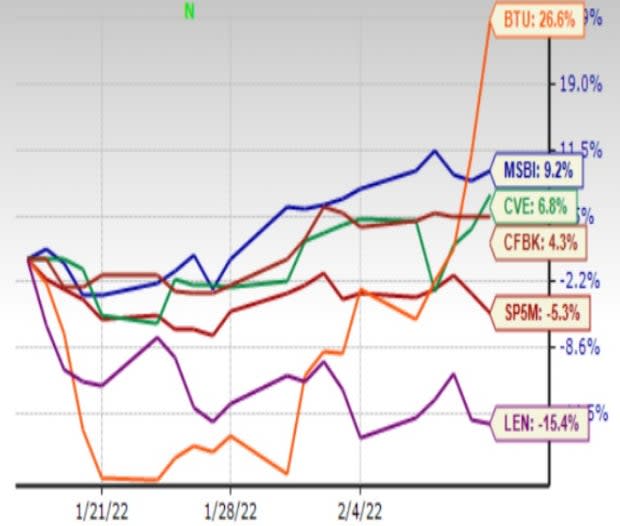Inflation Beyond the Fed's Control? How to Play Safe
While we’re debating what will happen if there’s a quarter-point, half-point or one-point increase in interest rates, it’s worth noting that not everything is in the Fed’s control. So although rate hikes will have a positive impact, other factors can offset to an extent the Fed’s efforts.
Number one external concern is the situation in Ukraine. It doesn’t help that Russia and the U.S. are blaming each other for the situation with Russia acting against the increasing deployment of NATO plus U.S. troops in all the countries surrounding it and the U.S. promising that this will continue if Russia doesn’t back off Ukraine.
For investors, this just boils down to reduced energy availability in the event that Russia attacks Ukraine and sanctions are imposed on it. And of course, reduced energy availability in an environment where it is already in short supply will ratchet up prices, which aren’t doing too bad anyway.
Higher energy prices translate to higher transportation costs which drive up prices of all goods and commodities. Or in other words, the Ukraine issue is directly linked to inflation.
Another factor driving inflation is the semiconductor shortage, which has the effect of shrinking availability of a host of finished goods (cars, consumer goods, phones, computers, home appliances, you name it… this is a really big group of products). And, like with anything else, when product availability is well short of demand, prices go up.
While efforts are on to reduce the gap between demand and supply, semiconductor capacity addition takes time to build and qualify. Even in China, where the building part is done super-fast. What this means is that we have to be patient. It will happen gradually. The Fed can’t do much about it.
The third factor is the supply chain where supply-demand imbalances, labor shortage and shipping containers are contributing to higher prices.
Ocean transport is expected to remain tight and expensive through most of this year. The Ocean Shipping Reform Act of 2021 was intended to serve as a check on shippers indiscriminately raising container prices and shipping charges and the Federal Maritime Commission’s (FMC) was given additional enforcement tools to improve control over maritime trade. Reciprocal trade agreements are also being tried to smooth out disruptions.
On the trucking side, the story remains much the same, with capacity constraints expected to continue through most of this year, in part because of the tight labor market.
Since the deregulation of the railroads in the 1980s, railroads have one from 40 Class I operators to seven. And four of these have the bulk of the freight railroading business, which makes for high prices and robust profitability.
Over the years, this profitability has grown manifold as they adopted a just-in-time approach to capacity building. So during the pandemic, these players were at first impacted by reduced shipments (which was kind of okay) and then inundated with them, (which really drove up prices). So the railroads' story, like trucking, is capacity- and labor-constrained. They also enjoy robust profitability, which they manage from price increases and fuel surcharges.
No wonder inflation is so high.
The Fed has limited scope to change this situation with immediate effect. What it can and has been doing, however, is tighten its purse strings. As a response to the pandemic, it has pushed trillions into the economy, and that money is one of the major contributors to the inflation. So while rate hikes and a rolling back of the balance sheet continues at the Fed, investors need to ensure that the hit to their portfolio is minimized.
That’s why there’s reason to look for inflation-proof -- or at least inflation-safe (stocks that have a good chance of beating inflation) -- options in the stock market. With the major indexes being where they are, this may be just the right time to jump in.
And for the reasons outlined above, stocks in the energy and tech sectors look like good places to be. Finance (particularly banks) could also do well, since higher interest rates are good for them, unless they come on too fast. Another sector that may be considered inflation-proof is construction, particularly the homebuilding industry, which is seeing its highest demand in decades, therefore allowing it to pass on increased costs to buyers.
Here are a few stocks that fit the bill-
Midland States Bancorp MSBI Zacks Rank #1 (Strong Buy) Value Score of A and Growth Score of A
Cenovus Energy CVE Zacks Rank #1 Value Score of B and Growth Score of A
Peabody Energy BTU Zacks Rank #1, Value Score B Growth Score B
Lennar Corp. LEN Zacks Rank #2 (Buy) Value Score A and Growth Score B
CF Bankshares CFBK Zacks Rank #2 (Buy) Value Score A and Growth Score B
Not only do they carry a Zacks Buy or Strong Buy rating, but they’re also undervalued based on P/E, P/S or both.
One-Month Price Movement

Image Source: Zacks Investment Research
Want the latest recommendations from Zacks Investment Research? Today, you can download 7 Best Stocks for the Next 30 Days. Click to get this free report
Peabody Energy Corporation (BTU) : Free Stock Analysis Report
Lennar Corporation (LEN) : Free Stock Analysis Report
Cenovus Energy Inc (CVE) : Free Stock Analysis Report
Midland States Bancorp, Inc. (MSBI) : Free Stock Analysis Report
CF Bankshares Inc. (CFBK) : Free Stock Analysis Report
To read this article on Zacks.com click here.
